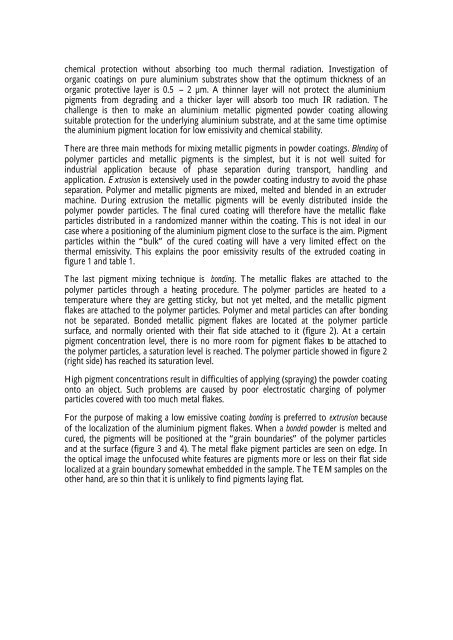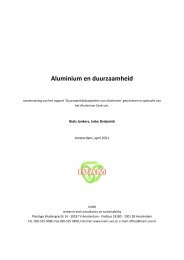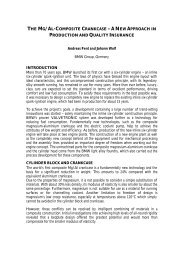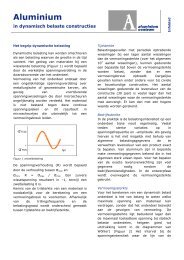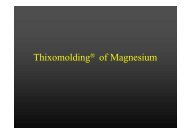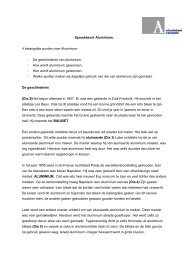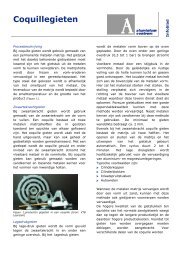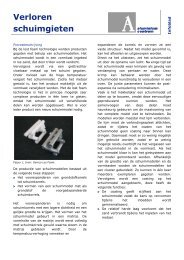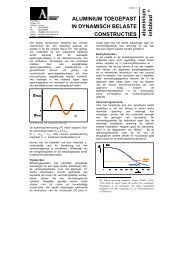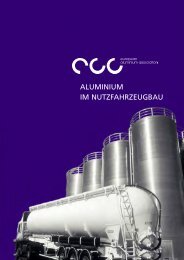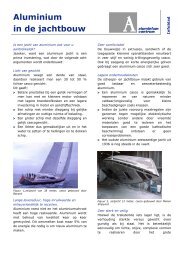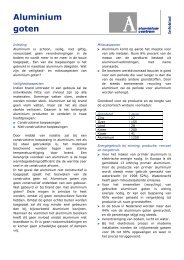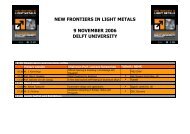2-Dr. Merete Hallenstvet - Het Aluminium Centrum
2-Dr. Merete Hallenstvet - Het Aluminium Centrum
2-Dr. Merete Hallenstvet - Het Aluminium Centrum
Create successful ePaper yourself
Turn your PDF publications into a flip-book with our unique Google optimized e-Paper software.
chemical protection without absorbing too much thermal radiation. Investigation oforganic coatings on pure aluminium substrates show that the optimum thickness of anorganic protective layer is 0.5 – 2 µm. A thinner layer will not protect the aluminiumpigments from degrading and a thicker layer will absorb too much IR radiation. Thechallenge is then to make an aluminium metallic pigmented powder coating allowingsuitable protection for the underlying aluminium substrate, and at the same time optimisethe aluminium pigment location for low emissivity and chemical stability.There are three main methods for mixing metallic pigments in powder coatings. Blending ofpolymer particles and metallic pigments is the simplest, but it is not well suited forindustrial application because of phase separation during transport, handling andapplication. Extrusion is extensively used in the powder coating industry to avoid the phaseseparation. Polymer and metallic pigments are mixed, melted and blended in an extrudermachine. During extrusion the metallic pigments will be evenly distributed inside thepolymer powder particles. The final cured coating will therefore have the metallic flakeparticles distributed in a randomized manner within the coating. This is not ideal in ourcase where a positioning of the aluminium pigment close to the surface is the aim. Pigmentparticles within the “bulk” of the cured coating will have a very limited effect on thethermal emissivity. This explains the poor emissivity results of the extruded coating infigure 1 and table 1.The last pigment mixing technique is bonding. The metallic flakes are attached to thepolymer particles through a heating procedure. The polymer particles are heated to atemperature where they are getting sticky, but not yet melted, and the metallic pigmentflakes are attached to the polymer particles. Polymer and metal particles can after bondingnot be separated. Bonded metallic pigment flakes are located at the polymer particlesurface, and normally oriented with their flat side attached to it (figure 2). At a certainpigment concentration level, there is no more room for pigment flakes to be attached tothe polymer particles, a saturation level is reached. The polymer particle showed in figure 2(right side) has reached its saturation level.High pigment concentrations result in difficulties of applying (spraying) the powder coatingonto an object. Such problems are caused by poor electrostatic charging of polymerparticles covered with too much metal flakes.For the purpose of making a low emissive coating bonding is preferred to extrusion becauseof the localization of the aluminium pigment flakes. When a bonded powder is melted andcured, the pigments will be positioned at the “grain boundaries” of the polymer particlesand at the surface (figure 3 and 4). The metal flake pigment particles are seen on edge. Inthe optical image the unfocused white features are pigments more or less on their flat sidelocalized at a grain boundary somewhat embedded in the sample. The TEM samples on theother hand, are so thin that it is unlikely to find pigments laying flat.


